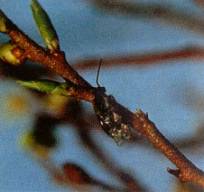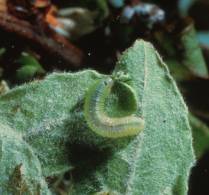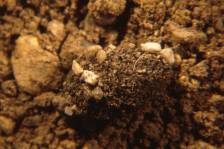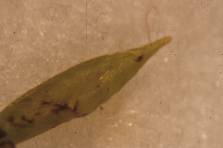206-Blueberry Sawfly (Neopareophora litura (Klug) )
Fact Sheet No. 206, UMaine Extension No. 2285
Prepared by Judith A. Collins, Assistant Scientist, and H. Y. Forsythe, Jr., Professor of Entomology, in cooperation with David Yarborough, Extension Blueberry Specialist, 1994. Updated by Lily Calderwood, Extension Wild Blueberry Specialist, 2020.
Description
Adults are ¼ inch long, black, and generally wasp-like in appearance but do not have the narrow waist usually associated with a wasp. They have membranous wings which they hold flat over their body (Figure 1).
The slow-moving, caterpillar-like larvae (Figure 2) are usually the color of blueberry foliage (grass green), which makes them difficult to detect directly on the foliage.
Fully grown, larvae are about 4/10 inch long. When feeding, they usually coil their body over the edge of the leaf and chew around the edge. Pupae are enclosed in a camouflaged cocoon in the litter (Figure 3).
- Photo 1: Adult
- Photo 2: Larva
- Photo 3: Cocoon
- Photo 4: Egg slit
Life Cycle
Blueberry sawfly adults lay eggs in early to late May inside newly developing, still folded, leaf whorls of lowbush blueberries (Fig. 4). The eggs hatch and larvae emerge within one to two weeks. Larvae feed on leaf tissue inside the developing whorl, killing the new leaves and filling the interior of the whorl with their excrement, a flaky brown material.
Young larvae, which are rarely seen, are white or flesh-colored with blackheads and black legs. Older, green larvae begin to appear on the blueberry foliage in late May or early June when leaves are well-developed.
The larvae continue to feed on the foliage until mid to late June. After reaching maturity, the larvae move to the ground and spin cocoons in the litter where they spend the winter.
Damage and Economic Importance
Although not usually an economic concern to growers, in large numbers larvae may cause damage by defoliating the plants. Blueberry sawfly larvae feed on blueberry leaves from late May to late June. The damaged leaves have a scalloped appearance around the edges. Infestations are usually confined to isolated areas within a field.
How to Scout for Insects Using a Sweep Net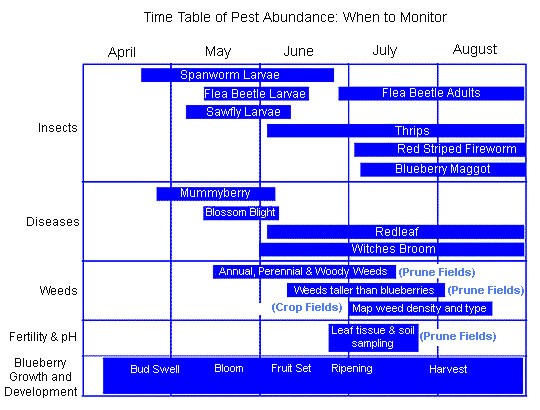
The sampling procedure to use for most insects (spanworm, flea beetle, sawfly, etc.) involves a single sweep of a 12-inch diameter net from one side of the body to the other (180 degrees). One sample is ten sweeps. While walking through the field, keep two hands on the handle and sweep the foliage. Do not take more than one sweep for every step, and be sure the net penetrates the foliage. After taking ten sweeps, shake everything into the bottom of the net. Empty the contents into a tray, box or other container, and count the number of insects of each species. Write down the results.
Number of samples: Take at least one set of ten sweeps every 100 to 200 feet. The number of sets of 10 sweeps (samples) should be about 10 to 20 for fields of 1 to 10 acres, 20 to 30 samples for fields of greater than 10 acres and less than 50 acres, and 30 samples for fields greater than 50 acres. Include weedy and rocky areas, field edges and “dips” or “hollows” in your sample; insects are commonly found in these areas. While walking to the next sample site, look around and note anything unusual, such as malformed or brown leaves; check these areas closely. Make notes or draw a map so that areas with suspected infestations can be located at a later date. Watch for defoliated areas within crop fields or delayed emergence of blueberry stems in pruned fields. However, do not automatically assume any area with no foliage has been damaged by an insect. Look for the evidence of feeding (chewed leaves and stems) and/or the presence of insects.
I have a 15 inch sweep net. Will that change the threshold I’m looking for?
The short answer is no. You can use either a 12 inch or 15 inch sweep net that has a “muslin” or cloth bag. Newly hatched span worm is one insect that will slip through the larger holes in a mesh net. Some sweep net suppliers include Bioquip, Forestry Suppliers, and Great Lakes IPM. Dr. Frank Drummond developed thresholds based upon a 12-inch sweep net, which is what you will find on the insect factsheets. When using a 15-inch sweep net, you do take a larger swath in a 180º sweep and therefore the relative abundance of the pest will be a bit different. A 12-inch sweep net has a 36 inch arc in each sweep, which is an approximate volume of 2034 sq inches of blueberry stems. A 15 inch sweep net will sweep a volume of 2543 sq. inches. Therefore, the 15-inch sweep net captures 1.25 times the volume of the 12-inch net.
For example, if your threshold is 10 caterpillars per set of 10 sweeps with a 12-inch sweep net, your threshold with a 15-inch sweep net would be 12.5 caterpillars per 10 sweeps. This is a very small difference that can be ignored especially because the threshold 15-inch net threshold is slightly more conservative, erring toward a safer estimate of pest pressure.
Pest Management
The blueberry sawfly can be controlled with an appropriate pesticide. Refer to Fact Sheets No. 209 for additional information on monitoring and control, or contact the lowbush blueberry specialist, University of Maine Cooperative Extension, 1.800.897.0757 (toll-free in Maine) or 207.581.2923.
Information in this publication is provided purely for educational purposes. No responsibility is assumed for any problems associated with the use of products or services mentioned. No endorsement of products or companies is intended, nor is criticism of unnamed products or companies implied.
© 2020
Call 800.287.0274 (in Maine), or 207.581.3188, for information on publications and program offerings from University of Maine Cooperative Extension or visit extension.umaine.edu.
The University of Maine is an EEO/AA employer, and does not discriminate on the grounds of race, color, religion, sex, sexual orientation, transgender status, gender expression, national origin, citizenship status, age, disability, genetic information or veteran’s status in employment, education, and all other programs and activities. The following person has been designated to handle inquiries regarding non-discrimination policies: Director of Equal Opportunity, 101 Boudreau Hall, University of Maine, Orono, ME 04469-5754, 207.581.1226, TTY 711 (Maine Relay System).

